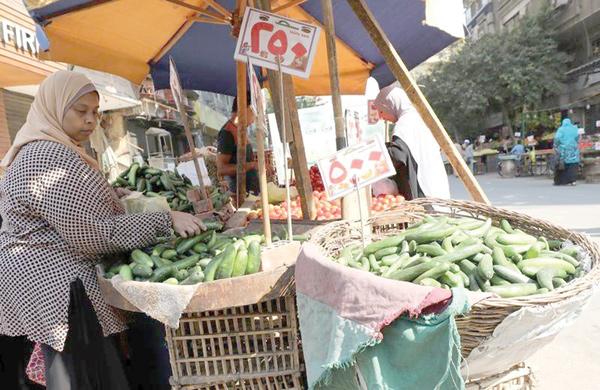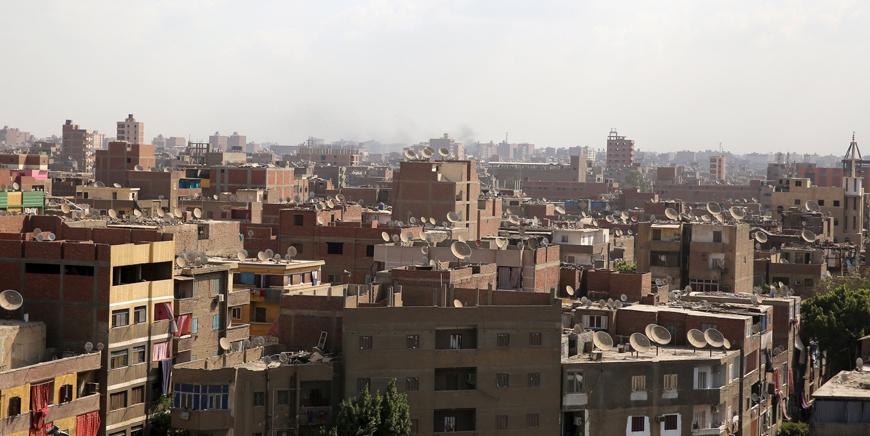You are here
Egypt targets 5 per cent economic growth by mid-2018
By Agencies - Dec 26,2016 - Last updated at Dec 26,2016

A poster of Egyptian President Abdel Fattah Al Sisi which reads ‘We will die and Egypt will live’ and the national flag are seen on a tree at the centre of downtown Cairo, Egypt, on Monday (Reuters photo)
CAIRO — Egypt targets a 5 per cent economic growth in the year to June 2018, the finance ministry said on Sunday as the government seeks to revive an economy battered by political turmoil.
Egyptian authorities have battled high unemployment, inflation and a collapse in tourism income since the 2011 uprising that toppled former president Hosni Mubarak.
President Abdel Fattah Al Sisi, who led the 2013 military overthrow of Mohamed Morsi, Egypt's first elected civilian president, vowed to get the economy back on track after his election the following year.
In a statement Sunday, the finance ministry said it aimed to "raise growth for 2017/2018 to 5 per cent" and to create "real, productive jobs that help lower unemployment to 11 per cent and raise citizens' incomes”.
Consumers have been hit by surging price hikes since November when Cairo floated its currency and slashed fuel subsidies as part of an economic reform package linked to a $12 billion International Monetary Fund loan.
The Egyptian pound had been pegged at 8.83 to the dollar, but has since weakened to more than 19 pounds to the dollar.
Egypt's inflation rate jumped to 19.4 per cent in November from 13.6 per cent the previous month, according to the central bank.
Despite its woes, the government has projected 5.2 per cent GDP growth in the year to June 2017.
Economic output grew 4.3 per cent in the year to June 2016, the ministry of planning said in November.
The finance ministry hopes to bring unemployment — which officially stood at 12.6 per cent from July to September — down to 11 per cent in the year to June 2018.
The ministry said it also wants to cut its budget deficit to 9.5 per cent of the GDP in the year to June 2018, down from 12.2 per cent the previous year.
It said it hopes to cut public debt to 94 per cent of the GDP in the year to June 2018, with a medium-term target of 80 per cent.
"The government will continue to implement a structural reforms package to support productive sectors especially industry and exports, while attracting investments," the ministry said.
It said it would press ahead with implementing a value-added tax and "policies to rationalise spending”.
Neanwhile, Sisi on Saturday said that the military's economic activity accounted for no more than 2 per cent of the country's output, dismissing suggestions that the military could control as much as half of the economy.
Speaking at an event celebrating the expansion of a military-owned company, Sisi said the military made up 1.5-2 per cent of economic output which he said was 3-4 trillion Egyptian pounds ($160 billion-$213 billion).
That would put the military's share of economic activity at between $2.39 billion and $4.26 billion.
"It has been said that the military's economy is worth 20 or even 50 per cent of the economy. I wish. We have nothing to hide; the military accounts for between 1.5 and 2 per cent of the economy," Sisi said, adding that the military paid taxes on all projects and that they were subject to regulations and auditing.
"We would love for it to be 50 per cent."
Sisi, a former general who took office in 2014, has promised to revive the economy, which has struggled since a 2011 uprising scared away investors and tourists, Egypt's main sources of foreign currency.
He has called in the military to assist in major infrastructure projects and with distribution of subsidised commodities to keep a lid on rising prices amid an acute shortage of dollars.
The economic weight of the military, which produces everything from bottled water to macaroni, has long been a topic of speculation in Egypt but official comment on the scope of its economic activities is rare.
Related Articles
CAIRO — Egypt's President Abdel Fattah Al Sisi has raised the country's minimum wage to 2,000 Egyptian pounds ($116) a month from 1,200 poun
CAIRO — As Egypt braces for austerity reforms, the military has expanded its economic role, at times helping President Abdel Fattah Al Sisi
CAIRO — Egypt's foreign currency reserves fell for the third consecutive month in September, according to central bank figures, putting pres


















